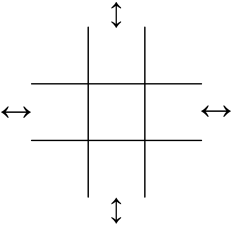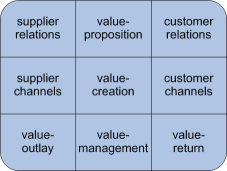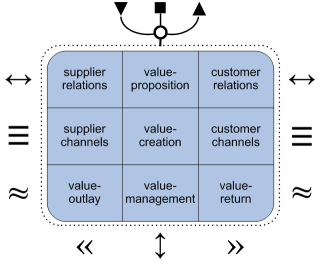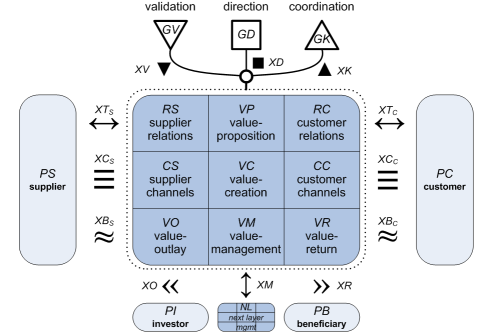The Enterprise Canvas: Summary and Index
There’s a lot of material in all of those articles on the Enterprise Canvas, so here’s an index:
- Introduction – a somewhat quirky lead-in to the background and reasoning behind the Enterprise Canvas model
- Part 1: Context and Value – introducing the ‘vertical’ dimension of the Canvas
- Part 2: Market and Supply-Chain – introducing the ‘horizontal’ dimension for the Canvas, and crosslinking it to the nature of the market
- Part 3: Owners and Managers – incorporating crosslinks to other stakeholders in the ‘vertical’ dimension
- Part 4: Layers – describing the structural changes that occur when modelling the crossmaps between layers of abstraction and implementation
- Part 5: Recursion, Flows and Systems – refining the utility of the Canvas with systems-theory and systems-models
- Part 6: Models – initial description of how to use the Canvas to model services and structures within architecture-practice
- Part 7: Patterns – four examples of typical patterns described by the Enterprise Canvas, in different business-contexts and at different architectural layers
- Part 8: Integration – describing crosslinks and usages with a range of other model-types commonly used in enterprise-architectures
- Summary and index
For the model itself, there are at least four different versions, depending on how you’re working and what you need to model.
The minimalist ‘back of the napkin’ version:
The ‘brick’, or grid version – the core nine-cell layout at the intersection of enterprise and value-web:
The ‘beetle’ version, including symbols for each of the related flows:
The ‘robot’ version, also summarising all of the stakeholders:
And another variant of the ‘robot’ version (‘robot chicken’?), with two-letter codes for each cell, interface and stakeholder:
Share and Enjoy, perhaps? And let me know how you get on with it, if you would?





I could be wrong but I suspect this work is a piece of genius.
I agree with you Peter. This is very good stuff and makes perfect sense. Business is complex. Tom is one of the few that adds clarity and also starts with vision and how vision ties to everything else.
Looks a LOT like the business model description from Alexander Osterwalder’s book “Business Model Generation” based on his Ph.D. thesis from about two years ago. I strongly recommend the book.
His map of interrelated concepts is the inspiration for the business model view of the Enterprise Business Motivation Model that I published last year. Take a look at the MSDN article or see http://motivationmodel.com
I will say that the canvas looks a LOT like something John Zachman would have invented if he had been thinking about business models… three rows, three columns. I’m not a fan of the icons, though. Not seeing the value of “yet another symbology” in the goal to make things clear and accessible by business leaders.
That said, it is a good distillation of prior work.
Hi Nick – thanks for the comments.
I’m guessing you posted this comment before looking in detail at the rest of the posts? – because yes, in some ways it’s designed deliberately to be closely compatible with Alex’s work. So yes, there is, intentionally, quite a lot of similarity on the surface, not least because it means that we can leverage people’s familiarity with BMC as a way to help them go deeper into the enterprise architectures. However, there are a lot of structural differences beneath the surface, as you’ll see as you read through the articles in more detail: examples include the emphasis on flows (both intra- and inter-service), the overall service-oriented model, the much stronger linkages to extended-enterprise/market and to supply-chain/value-web, the roles of and relations with investors, the linkage to the Viable Systems Model (more precisely, my Viable Services Model variant) that enables whole-of-enterprise integration, and the explicit layering from abstract to concrete. There is a lot of difference there, of which perhaps the most important point of all is that there’s a lot more to an enterprise than just its business-models.
Thanks for the reminder on your Enterprise Business Motivation Model: I probably need to update Part 8 of the Enterprise Canvas series to include a link? Need to go look at it again, too: we did talk about it some months back, I think? – an important item of work, anyway.
On Zachman and ‘three rows, three columns’, that’s actually where he started, all those years back – kinda growed since then… 🙂 I do disagree with you there: the single Canvas is radically different from Zachman’s taxonomy in both its structure, content and purpose, if you look at it in more detail, whilst the full set of Canvas layers – as explained in Part 4 – is actually a deliberate incorporation and extension of Zachman’s rows. You’ll see a bit more on how Zachman is actually used in this in Parts 6 and 8.
“I’m not a fan of the icons” – neither am I! 🙂 As I explained as I went through the articles, I couldn’t find any decent icons to put there, and since I was using Visio do the diagrams, I simply grabbed whatever keyboard-symbols I could find that would just-about do the job. When I have the chance (and the funding?) to do this properly, I would get someone like Alan Smith (the designer of the BMGen book) to create a decent set of icons: for example, two people talking, for the ‘relations’ link (horizontal double-arrow, at present); a parcel, for the main-channel ‘exchange’ link (identically-equal sign); and perhaps a pile of cash for the backchannel link (approximately-equal sign). The square and triangles actually come from the Viable System Model, and I retained them at present for backwards-compatibility: but again, they really do need better icons than that. So please don’t get hung up on its present appearance! – it’s best to think of what’s there now as a temporary kludge, nothing more than that.
And at the moment, yes, it’s essentially “a distillation of prior work”, one that I hope brings that work into more usable form. Do remember, though, that this is literally the first time it’s been out in public, and it really is only an alpha-version. With help from you and others, we should be able to mould this into something that really help us cover the whole of the scope in enterprise-architectures.
Thanks again, anyway.
Peter, Pat – thanks very much indeed: I hope you’ll find this useful to you, anyway, and would welcome any other suggestions you may have as to how we can improve this and make it work even better for everyone.
I’m planning another short series of articles with a full worked-example for this: I hope that’ll also help to clarify some of the practical questions about how to put this to real-world use.
Tom,
I’m a long time fan of your blog and want to pay homage to your amazing series of posts about the EC concept. Osterwalder’s work is brilliant and so is the EC. I hope that you are willing to share this with Alex O because if he refers to it in his book then the EC will get well deserved notoriety. I especially appreciate this work for its balance. Thanks for the insight.
Hi Alex – many thanks indeed.
I’m currently rewriting the EC material into book-format, and will let you know as soon as it’s available – please let me know if you have any comments or suggestions you’d like me to include.
And yes, I’ve been in contact with Alex Osterwalder over this, though I haven’t heard anything back from him about it as yet. I’m hoping to meet up with him at the Stockholm EA conference at the end of November, anyway.
Best wishes, and do keep in touch.